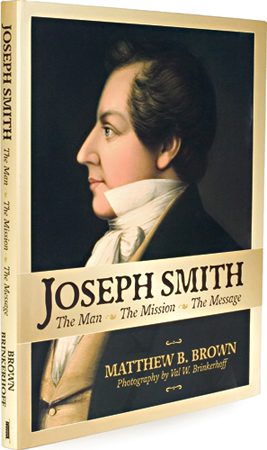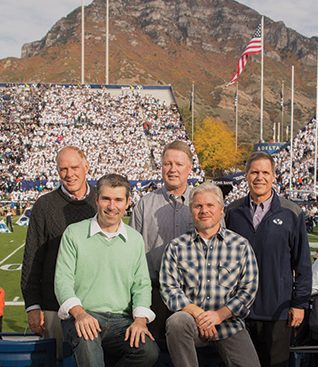By Richard H. Cracroft
Join me on a quick-paced, mind-swinging jog-walk through a selection of recent books written by alumni of Brigham Young University. The rules of the exercise are simple: 1) We’ll trot just fast enough that we can walk-talk without either becoming breathless. 2) I’ll do all the talking and you all the listening (you learned at BYU that a professor is one who talks in students’ sleep). 3) As usual, I’ll talk only about selected recent books by BYU alumni which I have winnowed and sifted and deem likely for your consideration. 4) Since we’re looking over our shoulders at space-stingy editors, I’ll leave the profundities of literary critique in your hands. Allons enfants! Tie on your intellectual Adidas and let’s “Rise and shout / And ramble about! / On our way to well-wrought stories.”
First, let me recommend three attractive art books for your Postum table: In Life in Zion: An Intimate Look at the Latter-day Saints, 1820-1995 (Deseret Book, 1995; 295 pp.; $24.95), William W. Slaughter guides us through an LDS photograph album packed with more than 200 photos, some familiar but most of them rarities. Sweeping visually across five periods of LDS Church history, Slaughter’s collection balances well-captioned, uncommon photos of LDS General Authorities with photos of workaday Mormons across the world.
The second Postum table delight is the visually stunning Images of Faith: Art of the Latter-day Saints (Deseret Book, 1995; 202 pp.; $49.95), with interpretive essays by editors Richard G. Oman and Robert O. Davis, senior curators at the Museum of Church History and Art in Salt Lake City. This volume presents, in nearly 300 full-color plates from the Church collection, expressions of faith in a variety of mediums of Mormon art from its foundations to international folk art of the 20th century. This visual and historical treasure does us all proud with its compelling display of the richness, variety, and spiritual power of LDS art.
The third book is The Mission: Inside The Church of Jesus Christ of Latter-day Saints (Warner Books, 1995; 224 pp.; $49.95), which oVers an in-depth look at the lives of Saints from Salt Lake City to São Paulo. This volume grew out of the efforts of 50 of the world’s finest photojournalists who, to mention but two examples, traveled with a group of Saints from Great Britain as they took food and supplies into war-torn Bosnia and went behind the scenes during the funeral preparations for the late Howard W. Hunter.
Some other noteworthy non-fiction books: LaVell: Airing It Out (Shadow Mountain, 1995; 191 pp.; $14.95), by LaVell Edwards with sportswriter Lee Benson, and foreword by Joe Paterno and a tribute by Steve Young. (If those names don’t ring any bells, move on at once!) Only incidentally a biography, this enjoyable book is a blend of LaVell’s thoughts about life as viewed through a gridiron and “LaVell stories” as told by fellow coaches, former players, friends, wife Patti, and their children.
You silver and gold alumni will remember Rose Marie Reid, successful swimwear designer, amazing businesswoman, and irrepressible Mormon missionary to the Jewish people. Additional sides this dynamic lady who overcame daunting obstacles with faith and works are revealed in Rose Marie Reid (Covenant, 1995; 220 pp.; $19.95), by one of her daughters, Carole Marie Reid Burr, and Roger K. Petersen. Jaroldeen Asplund Edwards’s Celebration! Ten Principles of More Joyous Living (Deseret Book, 1995; 150 pp.; $12.95) defines the act of celebration as “the conscious decision to live our lives with joy.” Edwards–talented mother of 12, church leader, novelist, and motivationalist–moves readers (me!) to celebrate the spiritual, the uplifting, and the lovely which are all about us.
If the cost of the five volumes of the Encyclopedia of Mormonism (1992) is too steep for your tithed and offeringed blood, you’ll rejoice to learn of The Church and Society: Selections from the Encyclopedia of Mormonism (Deseret Book, 1995; 633 pp.; $18.95), edited by Daniel H. Ludlow. This selection of roughly 300 articles from the Encyclopedia covers a wide variety of issues presently facing the Church and society. I also enjoyed the incomparable Hugh Nibley’s Brother Brigham Challenges the Saints (F.A.R.M.S. and Deseret Book, 1994; 541 pp.; $23.95). Edited by Don E. Norton and Shirley S. Ricks, this 13th volume in The Collected Works of Hugh Nibley, together with the entire series, recently won the 1994 Frankie and John K. Orton Award for LDS Literature.
Jacques Maritain wrote that “fiction diVers from every other art in one respect: it concerns the conduct of life itself.” At long last readers of Mormon fiction can discern “the dawning of a brighter day,” as more LDS storytellers turn to creating characters who conduct their lives, regardless of the nature of their inevitable personal struggles (tension is the basic dynamic of fiction and mortality), as Latter-day Saints who have faith in the higher reality and seek to live Christo-centrically in a twilit and a transitory world. That is one of several reasons why I enjoyed the well-wrought novel by Michael Fillerup, Beyond the River (Signature, 1995; 252 pp.; $9.95). Protagonist Jon Reeves is a returned missionary, husband, father, bishop’s counselor, and frustrated would-be writer who is suffering from an overdose of mortality, floundering his way through a mid-life crisis toward an elusive reconciliation with his past, present, and future. Happily, Fillerup demonstrates that the tensions requisite to quality fiction need not be those based in infidelity, disaffection, rebellion, and loss of faith, but can be found aplenty in the daily perils of discipleship by protagonists who cope with the grey complexities of mortal life with an anchor of faith in God, the Lord, and first principles. Fillerup sustains a powerful unifying symbolism and believable characters–and nobody even comes close to getting excommunicated!
Another well-turned story is Marilyn Brown’s timely new novel, Statehood (Aspen Books, 1995; 322 pp.; $9.95). Brown has set her story in 1890s Salt Lake City, at the turbulent time just prior to the Manifesto and near the end of the LDS struggle to accommodate divinely mandated plural marriage with coercive U.S. sanctions and withholding of long-sought statehood. Brown, who breaks new fictional ground in this historically founded story, shows both sides of the controversy through the points of view of outsider John Sewell, a Gentile newspaper reporter from Boston, and Libby Walker Dawson, the young widow of a polygamous Saint, and centers both viewpoints in President George Q. Cannon. Brown weaves an eventful and instructive story about a little understood and turbulent time in Utah and LDS history.
Orson Scott Card presents Alvin Journeyman (TOR, 1995; 381 pp.; $24.95), the long-awaited fourth novel in The Tales of Alvin Maker saga. Fantasy’s distancing yet intensifying focus enables Card to put a fresh and illuminating slant on prototype Joseph Smith’s challenges in founding the City of Zion through Maker Alvin Miller’s attempts to realize his city-building dreams in the face of opposition of the Unmaker. And in Earthborn (TOR, 1995; 378 pp.; $23.95), Card concludes his five-book Homecoming saga with a story line which suggests the books of Mosiah and Alma, as his earlier works in the series paralleled 1 and 2 Nephi.
These echoes of the Book of Mormon provide a familiar resonance to Card’s richly imaginative variations, from a 40-million-year perspective, of a variety of contemporary social and religious problems. Card, so far the most prolific and imaginative Latter-day Saint writer, again posits, with Fillerup and Brown, rich possibilities of an LDS fiction which speaks imaginatively from the orthodox center of the faith and not from the heterodox fringe.









